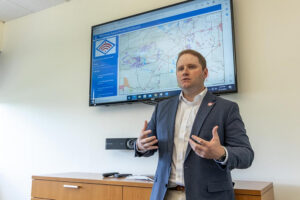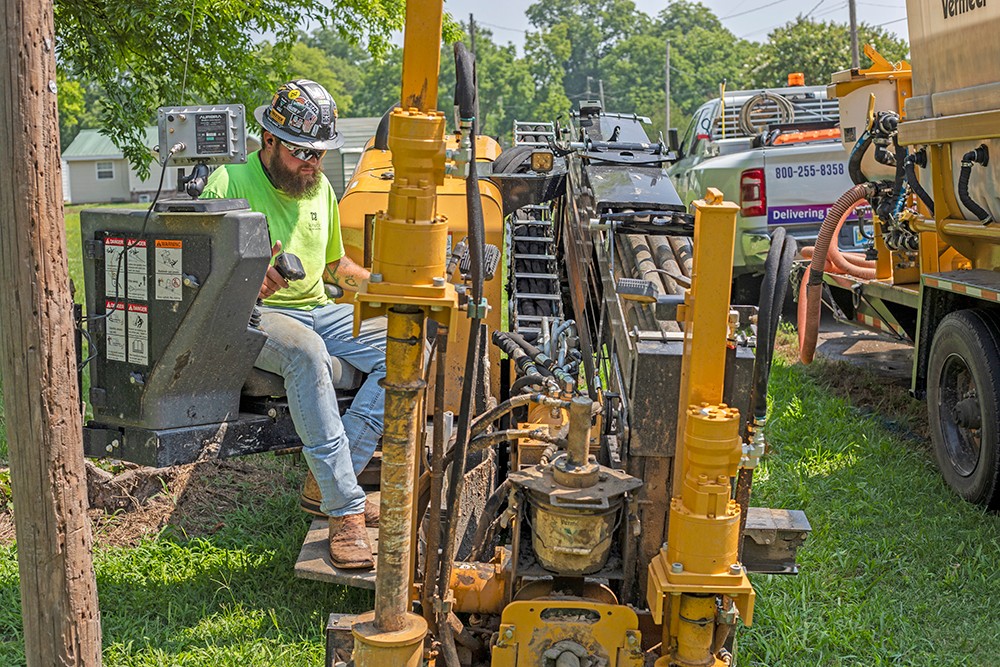A Kinetic worker uses a horizontal directional drill in Swifton. The drill opens the ground, inserts broadband fiber and runs it horizontally for 300-400 feet before bringing it up again to connect to the customer.
Monday, Jul. 17, 2023 12:00 am 4 min read by Lara Farrar https://www.arkansasbusiness.com/staff/lara-farrar

Glen Howie
Glen Howie, the state’s broadband director: “We are going to do our very best to make sure the $1 billion is put to use in the most effective manner.” (*Phillip Davis*)
For about six months, Sandy Martin, a member of the Carroll County
Broadband Committee, has been meeting regularly with other members to
listen to area residents about the challenges they face with internet
access.
The 14-member committee has learned that most chicken growers in the county
only have dial-up internet access. They’ve learned that in the Green Forest
School District, about 65% of students do not have internet at home. First
responders have told them that there are elderly residents who have no way
to call for help or access telemedicine appointments with doctors because
they have no internet service.
With more than $1 billion in federal funding for broadband infrastructure
https://www.arkansasbusiness.com/article/144997/arkansas-receives-1-billion-grant-for-statewide-internet-access
expected to arrive in Arkansas beginning next year, the state, for the first time,
has launched a comprehensive campaign to learn from communities about the
challenges that continue to persist with access to reliable high-speed
internet.
Those in the broadband infrastructure industry say that the $42.45 billion
from the Broadband Equity, Access & Deployment, or BEAD, program, of which
Arkansas is receiving $1.024 billion, could be the last significant funding
opportunity for states to build out internet infrastructure in rural areas
and finally close the country’s digital divide.
“We will have enough money to finish the job,” Glen Howie, the state’s
broadband director who was appointed to the position last summer
https://www.arkansasbusiness.com/article/140586/glen-howie-to-lead-arkansas-broadband-office,
told Arkansas Business.
“The No. 1 priority for us is to connect every remaining unserved and
underserved location in the state,” Howie said. “We have a long way to go.
We have a lot to do, but we are going to do our very best to make sure the
$1 billion is put to use in the most effective manner.”
About 215,000 homes and businesses in Arkansas still do not have any
internet access or are in need of upgrades to high-speed broadband
infrastructure, according to Howie. He recently wrapped up a listening tour
of the state’s 75 counties, 35 of which now have broadband committees, like
the one in Carroll County, that are surveying residents to provide feedback
on challenges to internet access.
It’s a daunting task to prepare a blueprint for how the $1 billion will be
used in Arkansas. That plan needs to be submitted to the National
Telecommunications & Information Association before the end of the year.
Howie said he expects a first round of public bids for projects to begin
sometime in 2024.
For many states, including Arkansas, an office dedicated to broadband
planning is a new phenomenon. For decades, addressing the digital divide
has been largely a piecemeal approach, with states having to find money in
state general funds for projects, Howie said.
That all changed around the time of the pandemic when federal funding
became available for projects after COVID-19 made clear that access to
broadband was no longer a luxury but a public utility needed for work,
health care, education and to communicate crucial information about a
public health crisis.
Since 2020, more than $1 billion in broadband infrastructure grants have
been awarded in Arkansas, covering about 330,000 locations. Of those 185
projects, 103 have been completed, 60 are still under construction and 22
are about to break ground.
Rural internet access remains an economic challenge. Building out fiber
internet infrastructure is expensive, and with low populations in areas
like the Arkansas Delta, it could take years to recoup costly up-front
investments.
“The reason that rural is so difficult is really one of density,” said Jeff
Small, president of Kinetic, a business unit of Windstream Holdings of
Little Rock that provides broadband service to residential and business
customers. “There may be areas where there are 10 households or less for a
mile of fiber you have to build, so the cost of reaching those homes
becomes very, very heavy, and the ability to recover, through a rate base,
that investment becomes challenging.”
Since 2020, Windstream has been awarded about $56 million in grants
<https://www.arkansasbusiness.com/article/139296/windstream-awarded-523m-for-broadband-projects-in-18-states>
for 12 broadband expansion projects to about 17,000 customer locations in rural
Arkansas, including Grant, Dallas and Cleburne counties. The company is
investing private capital for projects in Elaine, Dierks, Swifton,
Murfreesboro, De Queen, West Fork and Tuckerman.
Identifying places that don’t have coverage is complex. Federal
Communications Commission maps of broadband access aren’t always accurate.
It’s an ongoing process to compare federal maps and state maps that may or
may not include neighborhoods where projects were recently completed or
that are part of different grant programs, like the Rural Digital
Opportunity Fund, another federal program to provide internet access to
rural areas via electric cooperatives.
A cursory analysis of an FCC broadband map shows vast areas in southeastern
Arkansas near Pine Bluff and western Arkansas around Mena that don’t have
coverage. Granular analysis of maps may show households on one street that
have internet while the next street is in the red.
The Arkansas State Broadband Office is tasked with analyzing this data,
then verifying its accuracy with residents in communities and internet
service providers. “This illustrates the complexity of this effort,” Howie
said. “There are multiple federal and state programs, and that inherently
makes this more complicated.”
Building internet infrastructure is just one component of the blueprint the
State Broadband Office is working on. The BEAD program also calls on states
to address the issues of the affordability of internet service and the
skills needed to use technology, like computers.
An estimated 274,000 Arkansans between the ages of 18 and 64 lack basic
digital skills, according to the State Broadband Office. A number of
nonprofits and advocacy groups devoted to closing the digital divide have
been joining the effort to devise solutions, ranging from workforce
training programs to providing access to affordable technology.
“Broadband access involves so many stakeholders, everything from providers
to policymakers to local nonprofits to agriculture, small business,
foundations and funders,” said Hunter Goodman, a professor with the
University of Arkansas Division of Agriculture Cooperative Extension
Service who has been involved with broadband access across the state.
“It is more than just putting a wire in the ground and turning on a switch.
It’s a long-term process that takes years and that may be difficult for the
average Arkansan who has waited so long for access to fully understand why
it just can’t be tomorrow.”

